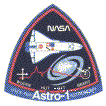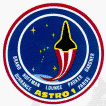|
|||||||||||||||||||
|
|
|||||||||||||||||||
|
|
Achievements of Astro-1
Over 40 hours of observations on 77 different celestial targets were obtained with HUT during the Astro-1 mission.. HUT was able to obtain spectra of key examples of almost every major class of astronomical object, ranging from distant galaxies and quasars to stars, star clusters, and clouds of gas and dust in our own Galaxy. Closer to home, HUT also observed familiar objects within our own solar system. When results from the other telescopes are added to those of HUT, it is clear that the Astro-1 mission was one of the most productive of all shuttle science missions to that time.
HUT scientists learned about conditions in the cores of active galaxies. These galaxies have unusually bright centers that may harbor massive black holes. As material falls into the black hole, it releases an enormous amount of energy that heats the surrounding gas clouds to high temperatures, producing bright ultraviolet emission. In one active galaxy, HUT observations found strong evidence for additional heating by shock waves. These and other data are being used to formulate a unified understanding of active galaxies. Evidence for the presence of massive black holes in quasars was also found.
Observations of the faint ultraviolet emissions in elliptical galaxies with HUT has shed new light on a 20-year old puzzle. These galaxies are composed almost entirely of old, cool stars which should not produce much ultraviolet light. HUT spectra characterized this faint UV glow at unprecedented levels and provided evidence for a new path of stellar evolution for old stars in these objects. Closer to home, HUT found new evidence for a hot, gaseous halo surrounding our own Milky Way Galaxy. A key absorption line found only in HUT's wavelength range shows this corona is several hundred thousand degrees hot and extends nearly 10,000 light years around the Galaxy.
HUT was used to observe a handful of binary star systems called cataclysmic variable stars, in which two stars are locked in very tight orbits about each other. (Look here for an artist's concept of a cataclysmic binary star.) Material from a normal star gets pulled off by the powerful gravitational attraction of the more massive star (a so-called white dwarf star), causing outbursts of intense UV light as the material falls onto the massive component. HUT observations provided new information about what happens in the hottest regions in these systems and found evidence for heating of the white dwarf by the infalling material. Astronomers also studied various diffuse nebulae in our Galaxy using HUT data. They learned about the characteristics of dust near hot stars, the speeds of shock waves produced by supernova explosions (look here for a picture of a supernova remnant), and gathered information on the chemical composition of this tenuous material in interstellar space.
HUT was also used to study objects in our own solar system. Jupiter's moon Io, the most volcanically active body in the solar system, spews material into space, where it is ionized by collisions with other particles and caught up in Jupiter's strong magnetic field. HUT observations have permitted a better understanding of the temperatures and densities of the resulting plasma. HUT was even used to observe a comet, which got just far enough from the sun in time to be the last observation made on the mission.
These are but a few highlights from a much wider range of accomplishments. Even so, HUT barely scratched the surface of all that could be learned from this unique spectral region. Luckily, we had a chance to expand on these initial results during a second space shuttle mission.


|
|
|




 Follow Us
Follow Us